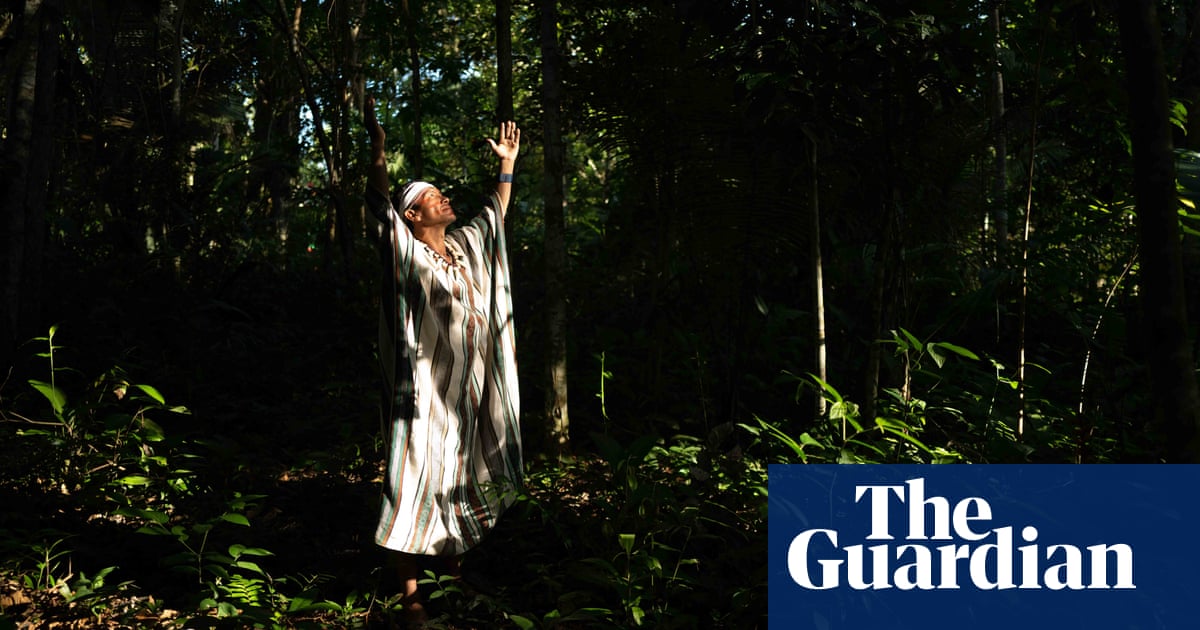
Sharpham Meadow doesn’t look much like a cemetery. There are no high walls, wrought iron gates or yew trees. You won’t find mausoleums or elaborate headstones. There are no signs of gothic horror. There are plenty of flowers but not the sort that come wrapped in cellophane – these ones are wild and alive. The whole place is wild and alive, with buzzing bees and birdsong.
And yet it is a cemetery or, as this land is unconsecrated, more correctly a burial ground. Spaced out evenly in rows are dozens of graves, simple mounds with a flat stone featuring just a name and dates. The view – over a Devon valley, the River Dart meandering towards its own end – is breathtaking. I wouldn’t mind ending up here.
I am here today to meet Rupert Callender, who set the place up a few years ago and ran it for a while. Actually, it’s a multilocation interview: we also go to his studio flat above an ice-cream shop in nearby Totnes and to his workplace on the edge of town. Plus, there’s the time we spend in his work vehicle, an old Ford Galaxy. With the back seats folded down he can just fit a coffin in there, so long as it’s not too ornate (and his aren’t: they’re generally cardboard or wicker). Today there are just a couple of boxes of human ashes in the back, waiting to be delivered.
Callender doesn’t look much like an undertaker. No dark suit, no obsequiousness or default expression of condolence, no Mr Sowerberry misery. He wears jeans, green trainers and a crinkly jacket, which makes him look more like a hippy of a certain age (he’s 52) or a university lecturer. Scholarly and lyrical, he slips effortlessly into and between Philip Larkin, Brian Eno and The Simpsons. Now he has written a book – part memoir, part rant against the traditional funeral business, part manifesto, part just musing on death and facing it with compassion and courage. It’s lovely and thoughtful and may make you rethink a few things.
Walking round the meadow, reading the names on the grave markers, Peaches the lurcher at his side, he remembers all the faces of the people he has buried. “There is Ant Peters buried here. One leg, really eccentric; he lived in a caravan.” Callender gets very involved with the people he buries and their families, something that takes its toll. “It’s hard being around extreme grief,” he says.
Callender does plenty of cremations too, although they are less green. He says it takes roughly the same amount of energy to cremate a body as it does to supply a living person with all their energy needs for three months. Then there’s all the CO2, the soot, formaldehyde, even mercury vapour that goes into the atmosphere. Burial has less impact on the environment. As long as it’s not done too deep, that is; the graves at Sharpham Meadow are all shallow ones. “If you bury somebody six feet down, there’s not enough bacterial activity to break them down,” he explains.
Callender’s vocation came to him in an epiphanic flash, in his 20s, while he was watching daytime TV. Channel surfing, he stumbled across a programme featuring the writer Nicholas Albery, who founded the Natural Death Centre, a charity that informs the public of their rights around funerals and encourages them to get more involved. “I was just catapulted off the sofa. It was like: ‘Oh my God, I’m an undertaker,’” says Callender, before adding: “I was stoned at the time.”
The vocational journey had actually begun much earlier, although he didn’t realise it at the time. He missed the funeral of his own father, whom he adored and who died when he was seven, because someone decided it would be too upsetting for such a young boy. He didn’t go to his grandparents’ funerals either. Soon after his father died, he was sent away to boarding school. It was a traumatic experience and, years later, it still occupies most of his therapy sessions. In contrast, he was exposed to kindness and humanity during the school holidays, watching his mother while she worked at a hospice, a place where dying is part of living. Death, both the negative and positive aspects of it, was all around his early life.
Callender’s mother died when he was in his mid-20s. He didn’t feel much of a connection to her funeral, he says, as he didn’t have any role. The pallbearers made an impression, though. “I was like: ‘Who are these weird men?’ Usually they’re ex-coppers; they’re basically hired to look solemn and to be the same height.” Callender is not a big fan of bearers, as well as a few other things about traditional funerals and the industry; we’ll come to them later.
At the time, he was drifting. He had inherited quite a lot of money, which he had squandered. He had tried eel fishing as a profession, but that one slipped away too. He was, basically, a trustafarian stoner. And a raver: he spent much of the 90s going to raves and doing everything associated with them. Nothing wasteful about that, though. “I really do think there was something very important which happened with acid house,” he says. It taught him about “connection” and “authenticity”, which he would later bring to his profession when he eventually found it. He even compares grief with the experience of tripping – they have that same feeling of hallucinatory unreality.
“I kind of feel sorry for people who are bereaved and haven’t tripped, because there’s something quite familiar about it when you go: ‘Oh, I get it.’ Time is very odd, there’s inappropriate laughter, people react in different ways. And the thing of when someone you really love dies, and the birds still sing, people laugh, it’s an outrage. You’re like: what’s going on? Don’t they know what has happened?”
Death seems to surround Callender, not just at work but at home. We’re in his little flat now, which is full of random strange objects: images of saints, sprigs of dried gorse, a plastic skull he says represents a Haitian spirit called Papa Gede, the embodiment of the corpse of the first man to ever die. Callender is not religious, but he likes the ritual and the magic. “I don’t think there is an afterlife; I wish there was,” he says. “My greatest hope these days is that time is an illusion and we find that everything is happening at once.”
After seeing Albery on the TV, Callender got a copy of his guide, The Natural Death Handbook. He discovered that you don’t need a licence or any qualifications to be an undertaker; you don’t even need to use an undertaker, or a priest, and you can bury bodies on unconsecrated ground. Much of the ritual and tradition of funerals is the creation of the industry, and of the church.
So he just did it. He got advice from another pioneer of alternative, green funerals, who introduced him to his first corpse; he bought a refrigeration unit, a stretcher and an old Volvo estate that would be his hearse for many years. And that was it – Callender was an undertaker. The first person he buried was an ex-postman called Barry.
Callender learned on the job, partly from making mistakes, but mainly from the people whose wives, husbands and children he was burying. In his book, the accounts of those first jobs have moments of comedy in them, but they are also moving and inspiring. There was the woman whose husband killed himself unexpectedly, but somehow she still managed to demonstrate to Callender that it offered an opportunity. He often speaks at the funerals he presides over, and that is at the heart of what he believes and tries to do. “Death obliterates the trivial, puts all the banality of our unthinking daily routine in the shade for a moment,” he writes. “If you can command and hold that space, you can say something enormous yet deeply simple, that nobody can disagree with, about what it means to live our lives.”
‘Hello, Ru,” he’s greeted a couple of times on the street outside. Callender remains friends with many of his former clients and he is well known around Totnes. “I’ve pretty much buried everyone,” he says. We’re on the way to see his workplace.
In learning the ropes, Callender had some help and support from some long-standing families of undertakers (the usual route into the job). But he found a lot that he didn’t like about the industry and funerals. Those bearers, for one, along with Victorian pomp, carriages and limousines. “I think content is more important than stuff,” he maintains. It’s a macho world, dominated by big faceless corporations, bastions of conservatism. He doesn’t like conveyor-belt crematoriums; a 20-minute slot then it’s on to the next one.
Nor is he a fan of euphemisms such as “loved one” and “passing away”. Death shouldn’t be airbrushed, he thinks. And he really doesn’t like embalming. If you read his description of what it involves – stabbing the organs and sucking out blood and guts, before pumping the body full of chemicals – you probably won’t like it either. And all so that someone can look younger and pinker and nothing like the person who died.
We are at his workplace now, a unit next to a bakery on an industrial estate on the edge of town. It’s much less romantic than Sharpham Meadow. He shows me the coffins he offers in cardboard and wicker with handles so that they can be more easily carried, even if you’re not ex-policemen of the same height who have nothing to do with the person inside the box. He encourages people to do their own bearing.
And for Callender, that’s what it’s about – getting involved. So what does he think is the perfect funeral? “People who loved that person talking honestly,” he replies. He generally gets things going and sets the tone. “And then someone else will speak and hopefully it just turns into a conversation that can run and run. Until we go: ‘Shall we do it? Shall we bury them?’ Then filling in the grave and sitting around on top of it afterwards having a picnic.”
And, Callender says, bring the kids along; they need to be there. He should have been at his father’s funeral. “We still get people going: ‘I don’t know about bringing Johnny.’ And I say: ‘Did he love his grandmother?’ And they say: ‘He adored her – he’s really upset.’ And I say: ‘If you don’t bring him, let me tell you, there’s a good chance he’ll end up as an undertaker.’”
What Remains? Life, Death and the Human Art of Undertaking, by Rupert Callender, is published by Chelsea Green.












